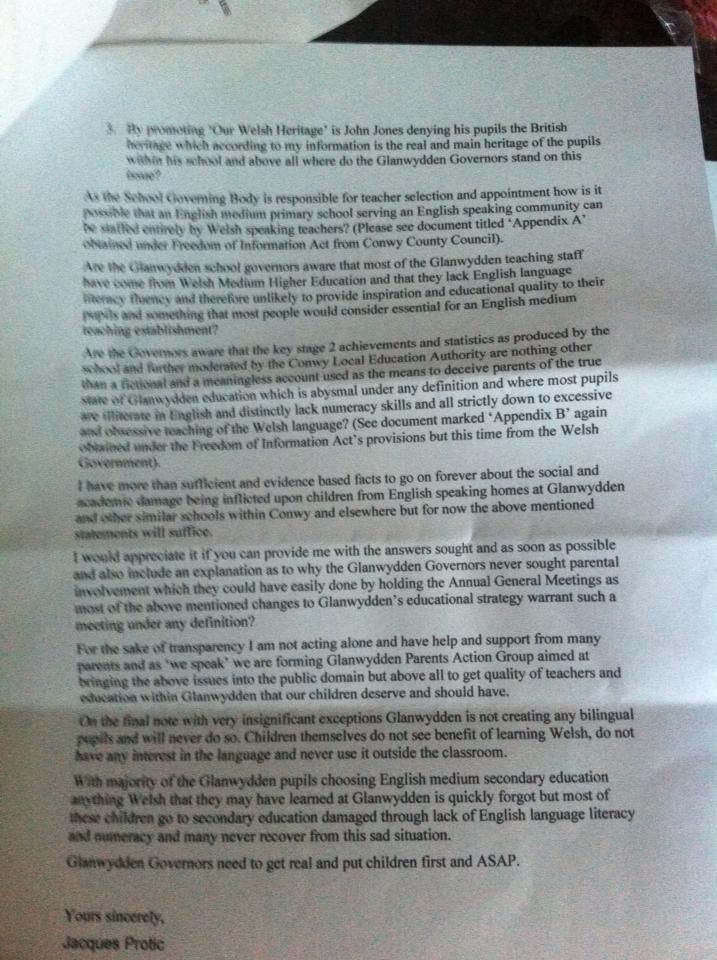I've always been proud of the fact that our National Assembly was the first in the world to have equal numbers of men and women. We weren't the first to have more women than men, though. The Basques beat us to that.
So it is a little sad that the number of women AMs has gone down since then. I came to the conclusion some time ago that anything in the 60% to 40% range was quite acceptable, and therefore don't think the 42% we have now is so bad, but it would have been right at the limit of acceptability if John Dixon's election had stood and Eluned Parrott not taken his place.
This means alarm bells should be ringing, and it's therefore right that Rosemary Butler and now Leanne Wood should raise the issue, for there is a real danger that the inequality might get larger in future unless we do something now to stop it happening. We should also remember that this problem exists to a far greater extent in elections to other bodies such as the UK Parliament (where only 18% of the 40 Welsh MPs are women) and local councils (where only 26% of the 1,266 councillors in Wales are women), so anything we propose should be extendable to those bodies as well.
-
The big question is to what extent legislation could be used to address this. I believe legislation could and should be used, but that it must be subject to two over-riding principles. The first is that nothing should interfere with individual voter choice, therefore any legislation should only be applicable to political parties. The second is that any legislation should be scrupulously equal to both genders, and should not favour one gender over another.
Perhaps the second of these principles is more contentious than the first. I do accept that "positive discrimination" might be desirable and necessary in some circumstances. But I think it should only be introduced if there is a major imbalance (and that it should only be a temporary measure until the imbalance is rectified) and if the balance could not be rectified (or would take a long time to rectify) by legislation in which both genders were treated equally. This means that positive discrimination might well be appropriate when appointing people to positions that existing incumbents doing the same job could hold for another twenty or thirty years, but that it is not appropriate for elections that are held every four or five years.
As it happens, the electoral systems we currently use are ones in which the choice of candidate rests almost exclusively with political parties. There is therefore room for legislation to help ensure gender equality, but we need to accept that legislation can only achieve this to a certain extent. If I had my way I would change the voting system for all elections to the Single Transferable Vote, and this is the view of both Plaid Cymru and the LibDems as well as some people in other parties. But assuming we are stuck with our present voting systems, I think we could introduce the following legislation for the different types of election we hold.
1. First-past-the-post elections
In a first-past-the-post system which elects one representative per constituency (i.e. MPs and constituency AMs) I think it would appropriate to set a rule that each party should field an equal number of candidates of each gender on a region-by-region basis ... though if a particular region had an odd number of seats, the party would of course be free to decide either way for the final seat.
The major objection to this is that it could cut across the right of a local constituency party to choose its own candidate. However I am not aware of any party that allows a constituency to choose its candidate without any input or oversight at all from the party in general, so I don't think the objection is particularly valid. Each party would of course be free to work out how it ends up with equal numbers as they see fit, but one easy way of doing it would be to group constituencies into pairs or foursomes.
Legislation of this sort would apply equally well on a UK-wide basis for Westminster elections. And it is very badly needed.
I think the size of region we have in Wales for National Assembly elections—between 7 and 9 constituencies—is about right, though it could perhaps be a little larger. If a region is much larger there is more room for circumventing the intention of the legislation by loading the "unwinnable" seats with candidates of the less favoured gender. So if, for example, things were done on an all-Wales basis, it would be possible for a party to put 20 candidates of one gender in the 20 seats they were most likely to win.
To illustrate how legislation would work in practice, we need only look to the 2011 election, where one party won all the constituency seats in South Wales Central and South Wales West, and all but one of the seats in South Wales East. This is an extreme situation, but requiring parties to field equal numbers of candidates of each gender in a region would ensure equal gender representation to within one seat. Legislation would be less effective in regions where one party did not expect to win nearly all the seats, but that shouldn't negate the principle. In fact it becomes particularly important when we consider that constituency seats are only part of the way we elect AMs, as will become clear in Section 4 below.
2. First-two-three-or-four-past-the-post elections
The principle of requiring parties to field equal numbers of candidates of each gender would also apply to the rather strange system we currently use to elect many—though by no means all—local authority councillors. In fact it would be particularly suitable for multi-member wards, and there is in fact a much greater need for it because only 26% of the local authority councillors we elect in Wales are women.
As a reminder of how the current system works; in a four-seat ward each voter has four votes, and the four candidates with the most votes are elected. It is very often the case that all four candidates elected are from the same party.
So I think it would be perfectly acceptable to legislate that each party must put forward an equal number of male and female candidates in each ward (or in the case of an odd number, a difference of only one). There would be little danger of the parties abusing this by, say, putting up four "no-hope candidates" of one gender alongside four "credible candidates" of another gender in a four-seat ward, for this would just split their vote. No party in its right mind would put up more candidates than there are seats available.
In local authorities where most or all of the wards are single-seat wards (Sir Benfro, Sir Gâr and Ceredigion for example) the same rules would apply as for first past-the-post elections as I described above, with the local authority being the region. But it might be even better to double up one-seat wards into two-seat wards.
The effect of doing this would be limited in local authorities in which a large number of independent candidates are elected, but there isn't much we could do or would want to do in such circumstances. However the legislation would apply where so-called "independents" stand together as a group and effectively form a party in all but name, but it would not apply to independent independents.
3. Closed list elections
The essence of a closed list system is that the voter can only vote for a party (or an individual not associated with a political party) and that the party decides the order of the candidates.
This system lends itself particularly well to gender equality legislation if the parties are required to alternate the gender of the candidates on their list. This is the way that elections in the three Basque provinces in Euskadi are organized, and as a result the number of men and women elected is always more or less equal. Each party is free to choose whether to put a man or woman in first place on their list.
However it would be slightly better (i.e. it would still produce the same gender equality, but would give the parties more flexibility) if, instead of alternating, the list was paired odd and even. A party would be free to put either a man or woman in the number 1 slot, but the person in the number 2 slot would have to be of the opposite gender. They would then be free to put either a man or woman in the number 3 slot, but the person in the number 4 slot would have to be of the opposite gender ... and so on.
Closed lists are used in the UK to elect MEPs, and I think it should be no problem to legislate that political parties must produce gender-paired lists for these elections. However because the UK euro-consituencies are relatively small (the largest being SE England with ten seats) the outcome of such legislation on gender balance would be limited, though not ineffective. Wales has only four seats, but such legislation would guarantee that if any party won two seats, we would have elected at least one male and one female MEP.
4. Mixed system elections
It is tempting to think that the regional AMs elected to our National Assembly are elected by a closed list system, but this is not actually true. They are elected by an additional member system designed to partially compensate for the unfairness of the first-past-the-post system used to elect constituency AMs. Which regional AMs are elected depends not only on the regional votes cast, but also on the constituency results in each region.
However the same mechanism that is used to help rectify any proportional imbalance between political parties can at the same time be used to help rectify any gender imbalance with one minor modification.
Firstly, parties would have to select an equal number of constituency candidates for each region as described in Section 1 above; and they would also be required to produce a gender-paired list as described in Section 3. The modification would be in the way any additional seats were allocated. Each party would get the same number of additional seats as it is entitled to now based on the same formula as is used now, but those individual seats would be allocated by gender.
If a party had won no constituency seats, or an even number of seats with an equal number of winning candidates of each gender, any additional seats they were entitled to in each region would be allocated in list order. However if a party had more winning constituency candidates of one gender than another in a particular region, any additional seats they are entitled to would be allocated to balance the overall number of men and women elected. It's probably best to illustrate how this would work with examples.
• If the party had won one constituency seat in the region, or a greater odd number with a gender imbalance of one (e.g. 2:1 or 3:2) then the first additional seat they were entitled to would go to the highest placed candidate of the gender that would give them equal numbers of male and female AMs, who might well be the number 2 on their list rather than the number 1. If they were entitled to two additional seats, the second additional seat would go to the highest remaining candidate irrespective of gender. If they were entitled to three additional seats, the third additional seat would be of the gender that would give them equal numbers of male and female AMs ... and so on.
• If the number of constituency seats a party won had a gender imbalance of two (e.g. 2:0, 3:1 or 4:2) then both the first and, if applicable, the second additional seat they were entitled to would go to the highest placed candidates of the gender that would give them a more equal number of male and female AMs. These might well be numbers 2 and 4 on the list. If they were entitled to three additional seats, the third additional seat would go to the highest remaining candidate irrespective of gender. In the unlikely event that they were entitled to four additional seats, the fourth additional seat would be of the gender that would give them equal numbers of male and female AMs.
• If the number of constituency seats a party won had a gender imbalance of three (e.g. 3:0, 4:1 or 5:2) then the first three additional seats they were entitled to would go to the highest placed candidates of the gender that would give them a more equal number of male and female AMs. These might well be numbers 2, 4 and 6 on the list. In the unlikely event that they were entitled to four additional seats, the fourth additional seat would go to the highest remaining candidate irrespective of gender.
• If the number of constituency seats a party won had a gender imbalance of four or more then any additional seats they were entitled to would go to the highest placed candidates of the gender that would give them a more equal number of male and female AMs. However in practice they might just scrape one, and would be very unlikely to be entitled to more.
At first glance, this might seem unfair to the number 1 candidate on a party's regional list, who could potentially be leapfrogged several times by lower placed candidates of the opposite gender, and might not get elected at all. But it isn't unfair. It would only affect those parties which had tried to circumvent the intention of the legislation by loading the winnable seats with candidates of their favoured gender. It would therefore would act as a powerful incentive for parties not to do it.
-
Gender is not always self-evident or obviously classifiable. So for the purposes of this legislation, I think that any transsexual candidate undergoing medical gender reassignment should be considered to be of their target gender, irrespective of how far along that path they might be. However there is a difference between a transsexual and a transvestite. A man could not be considered a woman just by dressing in drag and changing his name to Edna, or vice-versa.
-
Finally, I should repeat that my preferred solution is to do away with our existing electoral systems and use STV for all elections, with the sole proviso that every party would be required to field an equal number of male and female candidates in each multi-member constituency, or a difference of only one if they fielded an odd number of candidates.












